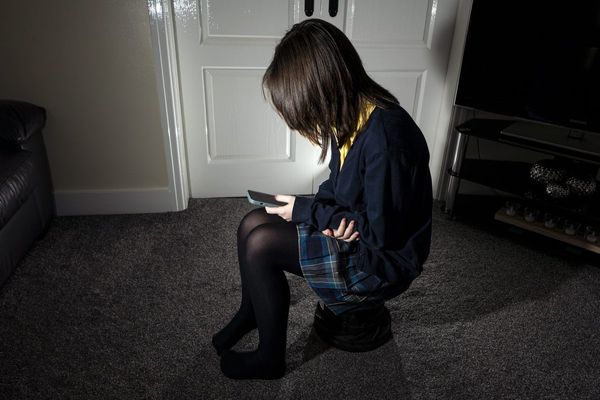
Deborah Hutcheon, a retired support worker, lives in Bristol. “I call this my hobbit house,” says Deborah, 61. “I bought it last June after just one rushed viewing. I needed to relocate from Essex to Bristol in a hurry, to be nearer my daughter, Holly, who’s 26 and was having a difficult pregnancy with her first child – my first grandchild.”
Deborah downsized drastically almost overnight. “My previous house, where I’d lived for 20 years, had two double bedrooms, with a separate living room, dining room and conservatory; whereas this has one bedroom and bathroom upstairs, and downstairs there’s a tiny kitchen and a living room that opens on to both the street and the garden.
“Everything happens in the living room – it’s my hallway, dining room, entertaining space and TV room. As it’s just over three by three metres square, that’s a lot to fit in.”
Although the house was small, it was perfect in terms of location. “I can’t drive long distances and it’s just five minutes from Holly,” says Deborah. “She had a very traumatic birth – Olivia was 12lb 6oz – and for the first few months they were back and forth to hospital. So, I’ve never regretted moving; I was exactly where I needed to be.”
Although the house served its purpose while Deborah was in crisis mode; over the winter the cramped space took its toll, particularly as she has clinical anxiety and depression, which worsens in the colder months. “Being stuck indoors, it felt cold, dark, claustrophobic and depressing – my heart would sink when I walked in the door,” she says.
“There was nowhere to put coats and shoes; my old furniture was too big for the space; the slatted blinds meant passers-by could see straight into the room; there was nowhere to eat dinner or sit with friends; all my belongings were piled everywhere and there was hardly any storage. I needed light, I needed privacy, and I desperately needed space to relax.”
IKEA believes that every home should be a sanctuary, but according to its 2021 Life at Home report, less than half of us say our homes meet our needs. Perhaps that’s not surprising given how hard our homes need to work these days – as offices and gyms, as well as places to rest and relax. So how can we get that feeling of sanctuary back?
First, we need to understand what sanctuary is. IKEA’s research found that it is made up of three elements: function – whether a room works as you need it to; emotional stability – whether the room makes you feel happy and calm; and space – or rather, the feeling of enough space (even a big room can feel cramped if poorly designed).



Deborah’s living room had a major space issue, which had a knock-on effect to how it functioned and how it made her feel. So, IKEA’s interior design team stepped in to help her make the house feel spacious. “With a small, tricky room like this, with lots of doors, windows and the stairs, you obviously have to work out how to maximise the space, but you also have to consider your needs and dreams, as well as the functionality – how you want to live in it,” says IKEA designer Clotilde Passalacqua. She is part of a team taking on three makeovers for the Guardian over the next few months, to show how little changes can make a big difference.
“We began by looking at what needs to happen in the space, as this will influence the final layout,” Clotilde continues. “For instance, when Deborah enters the house, she immediately needs somewhere to put her coat, shoes and keys, so we added hooks and a wall tidy by the door. And in the evenings, she needs somewhere she can sit and put her feet up, so we chose a comfortable compact sofa and footstool, and positioned them opposite the television. Everything else then fitted around this.”

When it comes to storage, being honest about how much stuff you want and need to find homes for is crucial. “Be realistic about how you live, and actually count your belongings before you buy anything, so that you pick the right solution,” says Clotilde. “There’s no point having a lovely shoe rack if it doesn’t fit all your shoes and you have to stuff the rest under the sofa!”
Giving everything a dedicated home will also help reduce clutter. “We used a Besta unit as a television stand and filled it with baskets and boxes, to keep Deborah’s bits and pieces neatly together in one place,” says Clotilde.
Another trick is to look for furniture with hidden functionality, and items you can use in more than one way. “The lid of the footstool lifts up to store blankets inside; while the top drawer of the Bissa shoe cabinet by the back door is being used for stationery rather than shoes,” says Clotilde.
Deborah was surprised by how much was fitted into the room. “I used to think that, to avoid a room feeling cluttered, less was more when it comes to furniture. But all you need is the right piece for the space. I’m surprised how many more places I have to put things now,” she says. “Things like the shoe rack and the picture ledge shelf behind my sofa – for displaying photos and mementos – are so clever, particularly as those walls were unused before.”
Smart small-space living is about using every inch without overwhelming the room. “Work out where to compromise,” says Clotilde. “Deborah needed a table and chairs for entertaining but was happy not to have them out permanently. She wanted to keep the cosy armchair from her previous house so we tucked a fold-up table and chairs behind it. Yes, she has to unfold them when guests visit, but it means she has that extra floorspace the rest of the time.”



Light has a big effect on the feeling of space in a room, and the team replaced Deborah’s clunky wooden blinds with a three-layered solution. “The Sandvedel roller blind inside the window recess stops people peering in, but still lets in plenty of light and leaves the windowsill free as a useful surface; and two layers of sheer curtains add softness, and can be closed individually or together,” says Clotilde.
For Deborah, it has achieved exactly the effect she wanted: “I love the way the light comes into the room now. I have privacy, but it’s much brighter, and the floaty fabric is so calming. It’s made such a difference.”
A few finishing touches – plants to bring the outside in; cushions for subtle colour and texture – and the transformation was complete. “It’s amazing how much bigger the room feels,” Deborah says. “Everything is hidden neatly away, and every piece of furniture has a purpose. From the draught excluder by the front door to the clip-on Ranarp lamp, which I can move around as needed and read by in the evenings, it all works so well, whether I’m entertaining, eating or just relaxing in here.”
Most importantly, Deborah has finally found the sanctuary she needs. “The whole room feels peaceful and serene. Instead of my shoulders slumping when I walk in the front door, I instantly relax.
“I’m proud of my home now and feel ready to tackle this new chapter in my life. It’s beautiful and makes me so happy. Now I no longer live in a hobbit house, but a mini-mansion!”
With inventive solutions for everything from clutter busting to lighting and decor, IKEA is on a mission to turn every home into a sanctuary. To find out more, go to IKEA.co.uk/designservice







